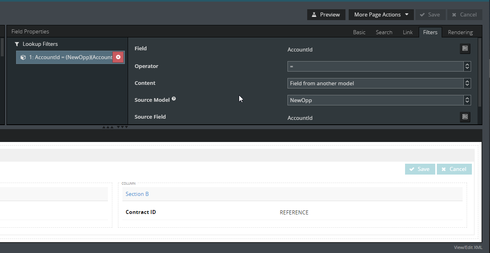I need search options in a lookup to be limited based on the value of another field. I could render a different “version” of the field for each scenario, but then I’d end up with 4 columns of the same field in the table since different rows would fall into different scenarios. Is there another way to do this?
Here’s the sitch:
Field A in Row A = Discharge, Field B Options are: Home, Affiliate
Field A in Row B = Leave, Field B Option is: Home
Field A in Row C = Transfer, Field B Options are: Affiliate, Non-Affiliate
It’s likely I’m failing at explaining this so let me know what additional details are needed. I’m trying to avoid this:
Field B V1 Field B V2 Field B V3 Field B V4
Row A = Discharge Affiliate
Row B = Leave Home
Row C = Transfer Non-Affiliate
Lauren,
You can set filter conditions on Lookup fields. Click on the field in the field editor and find the ‘Filters’ tab for the field’s properties. Here is a screenshot:

This is a new opportunity page with a filter set on the Contract lookup field to filter based on the selected Account.
Here is the sample page:
<skuidpage unsavedchangeswarning="yes" personalizationmode="server" showsidebar="true" useviewportmeta="true" showheader="true">
<models>
<model id="NewOpp" limit="1" query="false" createrowifnonefound="true" datasource="salesforce" sobject="Opportunity">
<fields>
<field id="AccountId"/>
<field id="Account.Name"/>
<field id="ContractId"/>
<field id="Contract.Name"/>
<field id="Contract.AccountId"/>
<field id="Contract.Account.Name"/>
</fields>
<conditions/>
<actions/>
</model>
</models>
<components>
<basicfieldeditor showheader="true" showsavecancel="true" showerrorsinline="true" model="NewOpp" uniqueid="sk-1VNq-282" mode="read">
<columns>
<column width="50%" uniqueid="sk-1VNq-278">
<sections>
<section title="Section A" uniqueid="sk-1VNq-279" collapsible="no">
<fields>
<field uniqueid="sk-1VNt-300" id="AccountId"/>
</fields>
</section>
</sections>
</column>
<column width="50%" uniqueid="sk-1VNq-280">
<sections>
<section title="Section B" uniqueid="sk-1VNq-281">
<fields>
<field uniqueid="sk-1VNt-301" id="ContractId">
<filters>
<filter type="modelmerge" operator="=" field="AccountId" fieldtargetobjects="Account" value="" model="NewOpp" enclosevalueinquotes="true" mergefield="AccountId" novaluebehavior="deactivate"/>
</filters>
</field>
</fields>
</section>
</sections>
</column>
</columns>
</basicfieldeditor>
</components>
<resources>
<labels/>
<javascript/>
<css/>
<actionsequences uniqueid="sk-1VNh-245"/>
</resources>
<styles>
<styleitem type="background" bgtype="none"/>
</styles>
</skuidpage>
Thanks,
Bill
Thanks, Bill. I’m aware of the filters…the problem is that I need more than one based on the value of another field. So ideally, I’d be able to do an if/then filter within that Filter tab, but that’s not possible (at least I don’t think it is?).
So if Field A is set to Transfer Out, then Field B needs to be filtered down to the options of Non-Affiliate or Affiliate. If Field A is set to Leave, then Field B needs to be filtered down to the option of just Home. If Field B is set to Discharge, then Field B needs to be filtered down to the options of Home or Affiliate.
Does that make sense?
Lauren,
I think I understand. I was assuming that you have a parent-child relationship between the object in Field A and the object in Field B. I think what you are saying is that you don’t have any relationship between the objects and that you would need more than just a parent-child. You need a many to many relationship between object A and B.
I think your best option is to setup a junction object between A and B. Then in your page, setup a model action that runs when Field A is changed. The action would set a condition on a model on the Junction object for field A, query the model, and bring back a list of object B that you would show in your reference field.
Thanks,
Bill
I run into this in native SF lookup filters as well. Another example is I want to be able to filter down the accounts that return to attach a contact to based on the record type of the contact. I’m not fully following your solution but I think I’ll just need to build it out in a sandbox and see. Thanks!
Reply
Enter your E-mail address. We'll send you an e-mail with instructions to reset your password.
